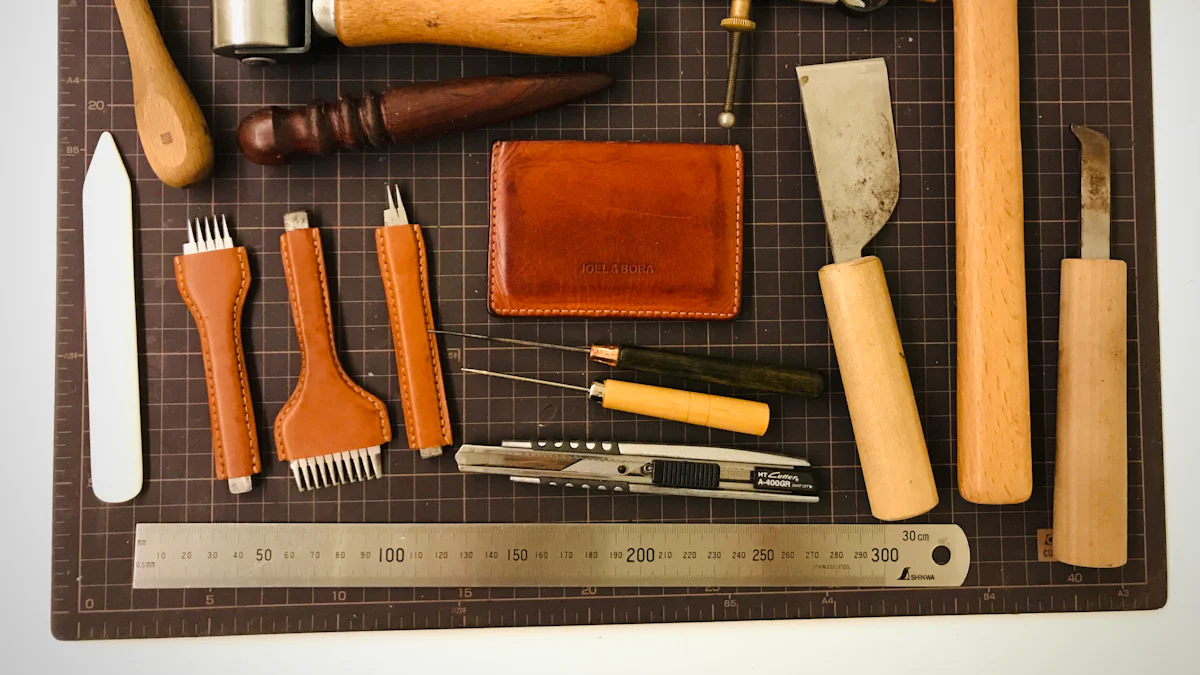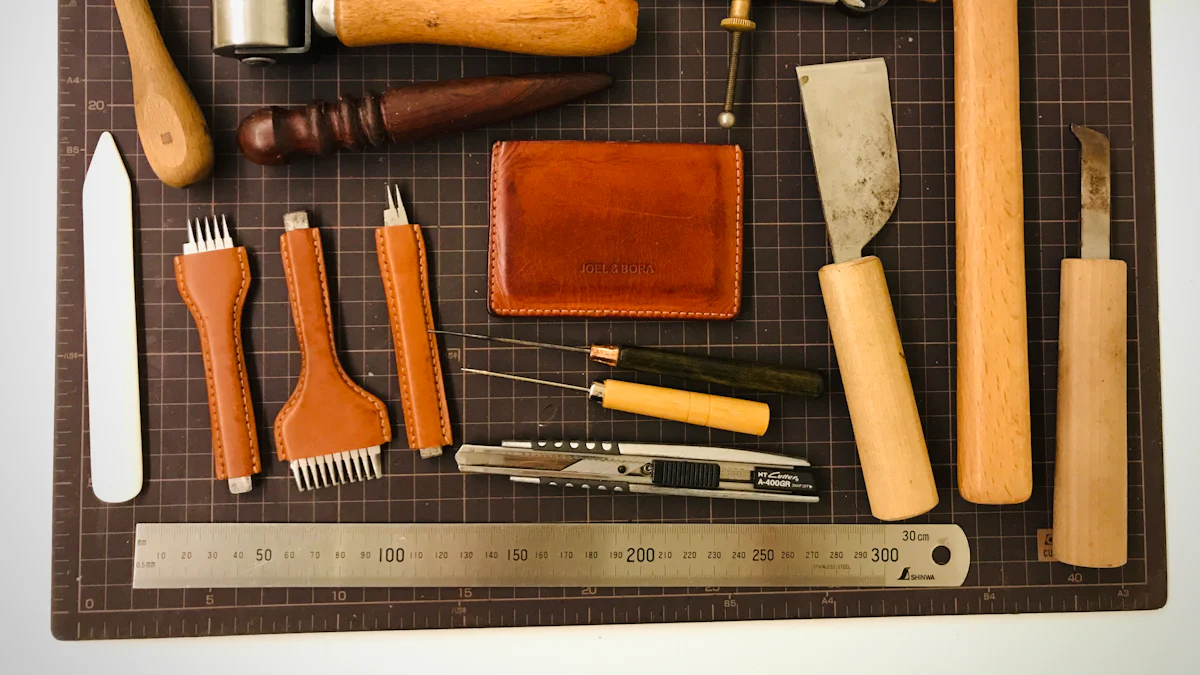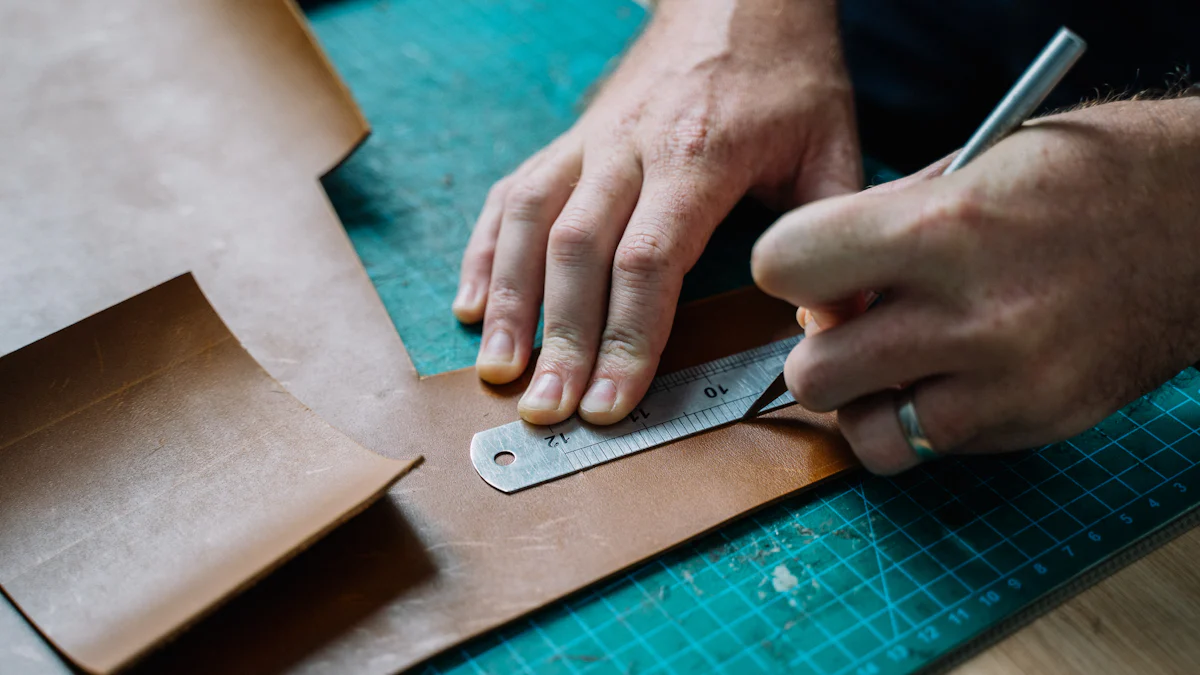
Leather cutting stands as a fundamental skill in the world of leathercraft. Mastering this art not only enhances the quality of finished products but also ensures precision and efficiency. The leather goods market continues to grow, with an expected growth rate of 5.40% by 2031. High durability and comfort make leather a preferred material for various products, including shoes, furniture, and apparel. Understanding the essential leather cutting tool and techniques is crucial for anyone aiming to excel in this craft.
Introduction to Leather Cutting
History and Evolution
Early Techniques
Hand cutting represents the earliest method of shaping leather. Artisans relied solely on dexterity and precision. Basic tools such as knives, scissors, and awls played a crucial role. Craftsmen meticulously cut and shaped leather to create garments and accessories. During the medieval and Renaissance periods, leatherworking flourished in Europe. Guilds regulated the trade and ensured quality standards. Leather workers specialized in tanning, cutting, and stitching. Wealthy patrons commissioned elaborate pieces adorned with decorative tooling and embossing. The use of leather reflected a taste for luxurious materials and sophisticated decoration.
Modern Advancements
Modern advancements have revolutionized leather cutting. Industrial machines now perform tasks once done by hand. These machines offer precision and speed. Computer-aided design (CAD) software allows for intricate patterns. Laser cutters provide clean and accurate cuts. Automation has increased production efficiency. Despite these advancements, traditional techniques remain valued. Many artisans still prefer hand cutting for custom and high-quality pieces. The blend of old and new methods enriches the craft.
Types of Leather
Full-Grain Leather
Full-grain leather stands as the highest quality. It retains the natural grain and imperfections. This type offers durability and develops a rich patina over time. Full-grain leather suits products like shoes, belts, and furniture.
Top-Grain Leather
Top-grain leather ranks just below full-grain in quality. Manufacturers sand and buff the surface to remove imperfections. This process results in a more uniform appearance. Top-grain leather remains durable and is often used for high-end goods.
Genuine Leather
Genuine leather comes from the lower layers of the hide. It undergoes processing to improve its appearance. Although not as durable as full-grain or top-grain, genuine leather offers affordability. This type is common in fashion accessories and budget-friendly items.
Bonded Leather
Bonded leather consists of leather scraps and fibers bonded together. A polyurethane or latex coating gives it a leather-like finish. Bonded leather is the least durable but the most economical. It is often used in low-cost furniture and bookbinding.
Understanding these types of leather helps in selecting the right material for each project. Each type offers unique characteristics suited to different applications.
Essential Tools for Leather Cutting

Cutting Tools
Utility Knives
Utility knives serve as a versatile leather cutting tool. These knives handle straight lines, curves, and intricate cuts. Leatherworkers often prefer utility knives for their precision and ease of use. A sharp blade ensures clean cuts, reducing the risk of frayed edges.
Rotary Cutters
Rotary cutters excel at creating clean edges in leather. These tools resemble round razor blades that roll along the surface. Rotary cutters are ideal for cutting long, straight lines. Beginners find rotary cutters user-friendly due to their efficiency and accuracy.
Leather Shears
Leather shears provide a powerful leather cutting tool option. These heavy-duty scissors cut through thick leather with ease. Leather shears offer control and precision, making them suitable for detailed work. The ergonomic design reduces hand fatigue during extended use.
Measuring and Marking Tools
Rulers and Measuring Tapes
Rulers and measuring tapes ensure accurate measurements in leather cutting. Precision is crucial in crafting high-quality leather products. Metal rulers paired with cutting wheels help achieve straight lines. Measuring tapes allow for flexibility when working with larger pieces.
Wing Dividers
Wing dividers assist in marking consistent distances on leather. These tools prove essential for pattern making and spacing stitches. Wing dividers ensure uniformity, enhancing the overall appearance of the finished product.
Marking Pens and Pencils
Marking pens and pencils play a vital role in outlining cuts on leather. These tools help transfer patterns onto the material. Leatherworkers often use erasable or water-soluble markers to avoid permanent marks. Accurate marking simplifies the cutting process and improves precision.
Safety Equipment
Cutting Mats
Cutting mats protect work surfaces and extend the life of cutting tools. These mats provide a stable base for cutting, reducing the risk of slips. Self-healing cutting mats close up after each cut, maintaining a smooth surface.
Safety Gloves
Safety gloves safeguard hands from accidental cuts and abrasions. Leatherworkers should prioritize safety by wearing gloves during cutting tasks. Durable gloves provide protection without compromising dexterity.
Eye Protection
Eye protection shields eyes from potential hazards. Leather cutting can produce small fragments and dust. Wearing safety glasses prevents eye injuries and ensures a safe working environment.
Techniques for Leather Cutting

Basic Cutting Techniques
Straight Cuts
Straight cuts form the foundation of leather cutting. Use a utility knife or rotary cutter for this task. Place the leather on a cutting mat to protect the work surface. Align a metal ruler along the desired cut line. Apply steady pressure and cut along the edge of the ruler. Ensure the blade remains sharp to achieve clean edges.
Curved Cuts
Curved cuts require precision and control. A leather cutting tool like a rotary cutter or utility knife works well. Mark the curve with a marking pen or pencil. Follow the marked line carefully, maintaining consistent pressure. Practice on scrap leather to improve accuracy.
Skiving
Skiving involves thinning the leather’s edge. This technique prepares leather for folding or stitching. Use a skiving knife or a specialized leather cutting tool. Hold the knife at a low angle and shave thin layers off the leather. Maintain even pressure to avoid uneven thinning.
Advanced Cutting Techniques
Pattern Making
Pattern making allows for the creation of custom designs. Use wing dividers and marking pens to outline patterns on the leather. Cut along the marked lines with a utility knife or rotary cutter. Precision in pattern making ensures uniformity in the final product.
Beveling
Beveling creates angled edges on leather pieces. This technique enhances the aesthetic appeal of leather goods. Use a beveling tool or a specialized leather cutting tool. Hold the tool at an angle and run it along the edge of the leather. Consistent pressure results in smooth, beveled edges.
Filigree Cutting
Filigree cutting involves intricate and decorative cuts. Use a fine-tipped utility knife or craft knife for this technique. Mark the design on the leather with a marking pen. Carefully cut along the lines, ensuring precision. Filigree cutting adds a unique touch to leather projects.
Tips and Best Practices
Maintaining Sharp Tools
Sharp tools ensure clean and precise cuts. Regularly sharpen utility knives, rotary cutters, and other leather cutting tools. Use a sharpening stone or strop for this purpose. Dull blades can damage the leather and compromise the quality of the cuts.
Proper Hand Positioning
Proper hand positioning enhances control and safety. Hold the leather cutting tool firmly but not too tightly. Position the non-cutting hand away from the cutting line. This practice reduces the risk of accidental cuts and improves accuracy.
Avoiding Common Mistakes
Avoid common mistakes to achieve professional results. Ensure accurate measurements with rulers and measuring tapes. Use a cutting mat to protect surfaces and extend tool life. Practice on scrap leather to refine techniques and build confidence.
FAQs on Leather Cutting
Common Questions
How to Choose the Right Leather?
Selecting the appropriate leather depends on the project requirements. Full-grain leather offers high durability and develops a rich patina, making it ideal for shoes and belts. Top-grain leather provides a more uniform appearance and suits high-end goods. Genuine leather, although less durable, remains affordable and works well for fashion accessories. Bonded leather, made from scraps and fibers, is economical and often used in low-cost furniture.
How to Sharpen Cutting Tools?
Maintaining sharp cutting tools ensures clean and precise cuts. Use a sharpening stone or strop to sharpen utility knives and rotary cutters. Regular sharpening prevents dull blades from damaging the leather. Consistent maintenance of cutting tools enhances the quality of leather projects.
How to Store Leather Properly?
Proper storage of leather preserves its quality and longevity. Store leather in a cool, dry place away from direct sunlight. Avoid folding leather to prevent creases; instead, lay it flat or roll it loosely. Use acid-free paper to separate different pieces and prevent sticking. Proper storage practices maintain the integrity of the leather for future use.
“Leather crafting is a journey. It’s filled with trials, errors, and aha moments. But with the right knowledge, tools, and space, it can be one of the most rewarding experiences. So, roll up those sleeves and dive into the world of leather. And remember, every piece you create tells a story. Make it a good one!” – Seasoned leather enthusiast
Mastering leather cutting requires understanding the tools and techniques. Key points include the importance of sharp tools, proper hand positioning, and selecting the right type of leather. Practice and experimentation enhance skills and build confidence. Leather crafting offers a rewarding journey filled with learning opportunities. Embrace the process and strive for precision. Each cut contributes to creating high-quality leather goods.
See Also
Complete Manual for Warm Winter with Soft Cozy Socks
Discovering the Range of Socks for Males and Females
